University Essay: Public Health Approach to Obesity (LC462, 2020-21)
VerifiedAdded on 2023/01/05
|9
|2618
|30
Essay
AI Summary
This essay delves into the arguments supporting a public health approach to combating obesity, contrasting it with individual-focused interventions. The introduction defines obesity and its health consequences, highlighting the need for effective government measures. The main body presents arguments for public health strategies, emphasizing their ability to address environmental, behavioral, and socio-cultural factors contributing to obesity. The essay discusses the impact of food marketing, changes in lifestyle, and the role of public health policies in promoting healthier choices. It also explores the advantages of public health initiatives, such as promoting physical activity and regulating food labeling. The conclusion reinforces the effectiveness of the public health approach, supported by research and the ability to address obesity at a broader, population-level scale.

Contemporary Debates
Paraphrase This Document
Need a fresh take? Get an instant paraphrase of this document with our AI Paraphraser
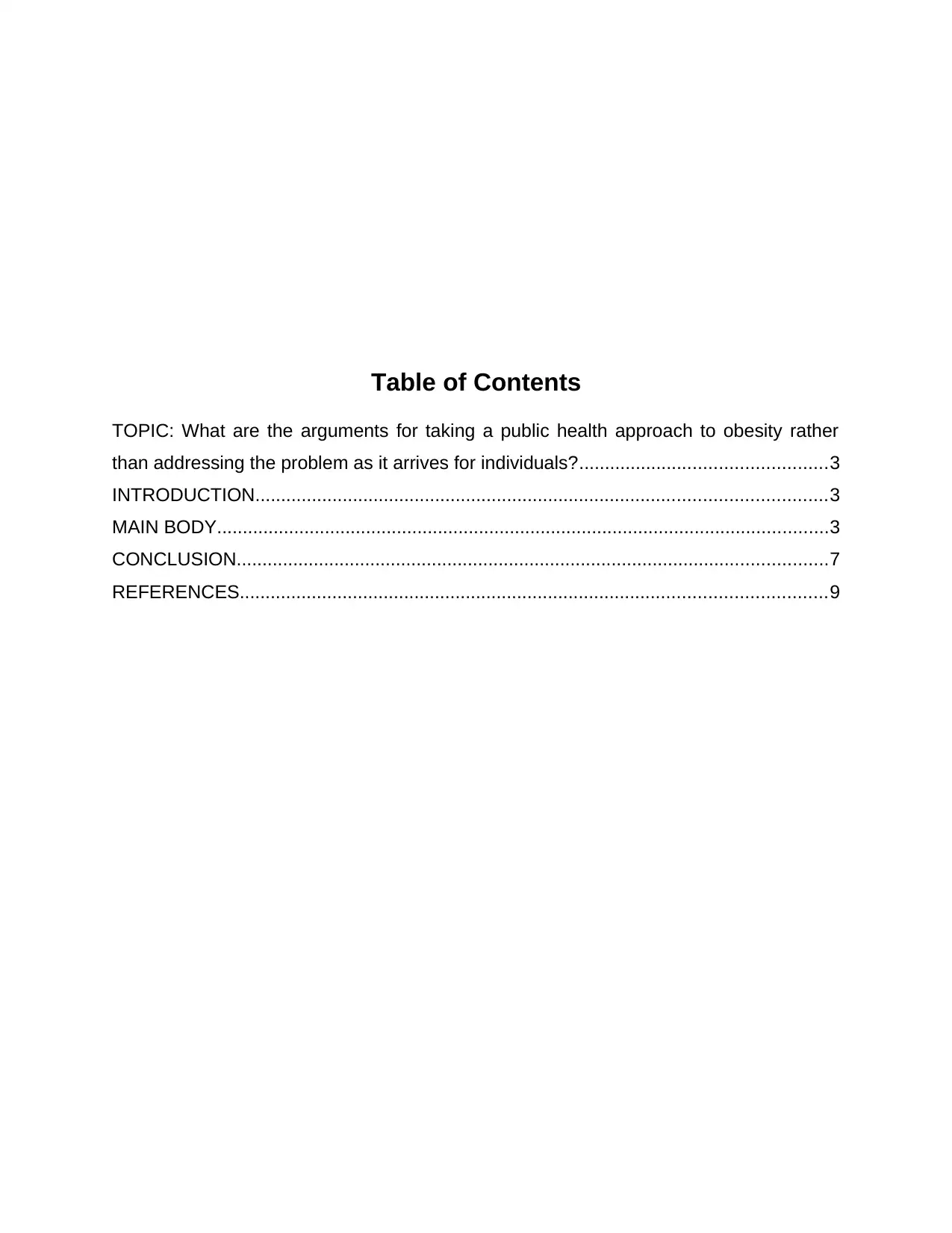
Table of Contents
TOPIC: What are the arguments for taking a public health approach to obesity rather
than addressing the problem as it arrives for individuals?................................................3
INTRODUCTION...............................................................................................................3
MAIN BODY.......................................................................................................................3
CONCLUSION...................................................................................................................7
REFERENCES..................................................................................................................9
TOPIC: What are the arguments for taking a public health approach to obesity rather
than addressing the problem as it arrives for individuals?................................................3
INTRODUCTION...............................................................................................................3
MAIN BODY.......................................................................................................................3
CONCLUSION...................................................................................................................7
REFERENCES..................................................................................................................9
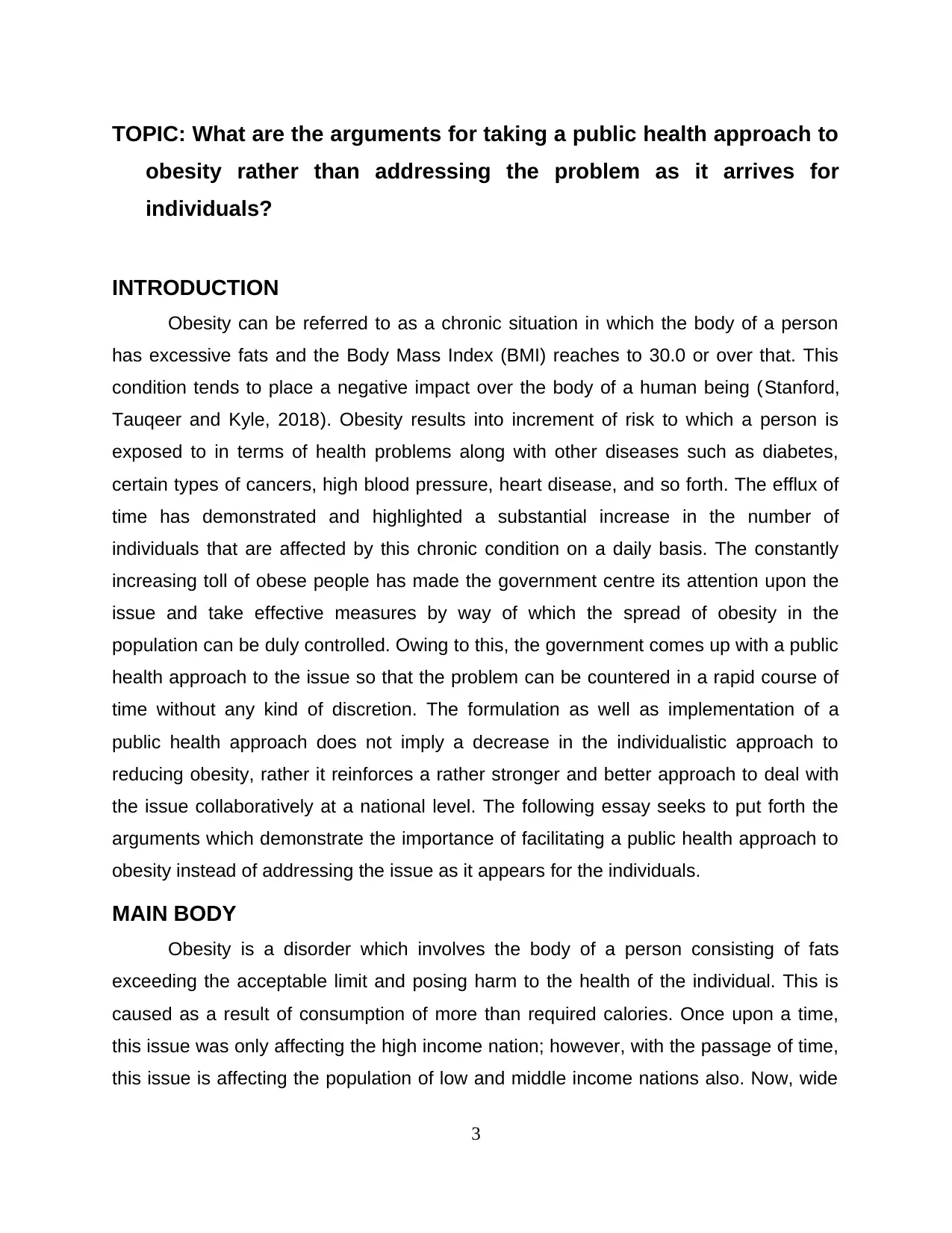
TOPIC: What are the arguments for taking a public health approach to
obesity rather than addressing the problem as it arrives for
individuals?
INTRODUCTION
Obesity can be referred to as a chronic situation in which the body of a person
has excessive fats and the Body Mass Index (BMI) reaches to 30.0 or over that. This
condition tends to place a negative impact over the body of a human being (Stanford,
Tauqeer and Kyle, 2018). Obesity results into increment of risk to which a person is
exposed to in terms of health problems along with other diseases such as diabetes,
certain types of cancers, high blood pressure, heart disease, and so forth. The efflux of
time has demonstrated and highlighted a substantial increase in the number of
individuals that are affected by this chronic condition on a daily basis. The constantly
increasing toll of obese people has made the government centre its attention upon the
issue and take effective measures by way of which the spread of obesity in the
population can be duly controlled. Owing to this, the government comes up with a public
health approach to the issue so that the problem can be countered in a rapid course of
time without any kind of discretion. The formulation as well as implementation of a
public health approach does not imply a decrease in the individualistic approach to
reducing obesity, rather it reinforces a rather stronger and better approach to deal with
the issue collaboratively at a national level. The following essay seeks to put forth the
arguments which demonstrate the importance of facilitating a public health approach to
obesity instead of addressing the issue as it appears for the individuals.
MAIN BODY
Obesity is a disorder which involves the body of a person consisting of fats
exceeding the acceptable limit and posing harm to the health of the individual. This is
caused as a result of consumption of more than required calories. Once upon a time,
this issue was only affecting the high income nation; however, with the passage of time,
this issue is affecting the population of low and middle income nations also. Now, wide
3
obesity rather than addressing the problem as it arrives for
individuals?
INTRODUCTION
Obesity can be referred to as a chronic situation in which the body of a person
has excessive fats and the Body Mass Index (BMI) reaches to 30.0 or over that. This
condition tends to place a negative impact over the body of a human being (Stanford,
Tauqeer and Kyle, 2018). Obesity results into increment of risk to which a person is
exposed to in terms of health problems along with other diseases such as diabetes,
certain types of cancers, high blood pressure, heart disease, and so forth. The efflux of
time has demonstrated and highlighted a substantial increase in the number of
individuals that are affected by this chronic condition on a daily basis. The constantly
increasing toll of obese people has made the government centre its attention upon the
issue and take effective measures by way of which the spread of obesity in the
population can be duly controlled. Owing to this, the government comes up with a public
health approach to the issue so that the problem can be countered in a rapid course of
time without any kind of discretion. The formulation as well as implementation of a
public health approach does not imply a decrease in the individualistic approach to
reducing obesity, rather it reinforces a rather stronger and better approach to deal with
the issue collaboratively at a national level. The following essay seeks to put forth the
arguments which demonstrate the importance of facilitating a public health approach to
obesity instead of addressing the issue as it appears for the individuals.
MAIN BODY
Obesity is a disorder which involves the body of a person consisting of fats
exceeding the acceptable limit and posing harm to the health of the individual. This is
caused as a result of consumption of more than required calories. Once upon a time,
this issue was only affecting the high income nation; however, with the passage of time,
this issue is affecting the population of low and middle income nations also. Now, wide
3
⊘ This is a preview!⊘
Do you want full access?
Subscribe today to unlock all pages.

Trusted by 1+ million students worldwide
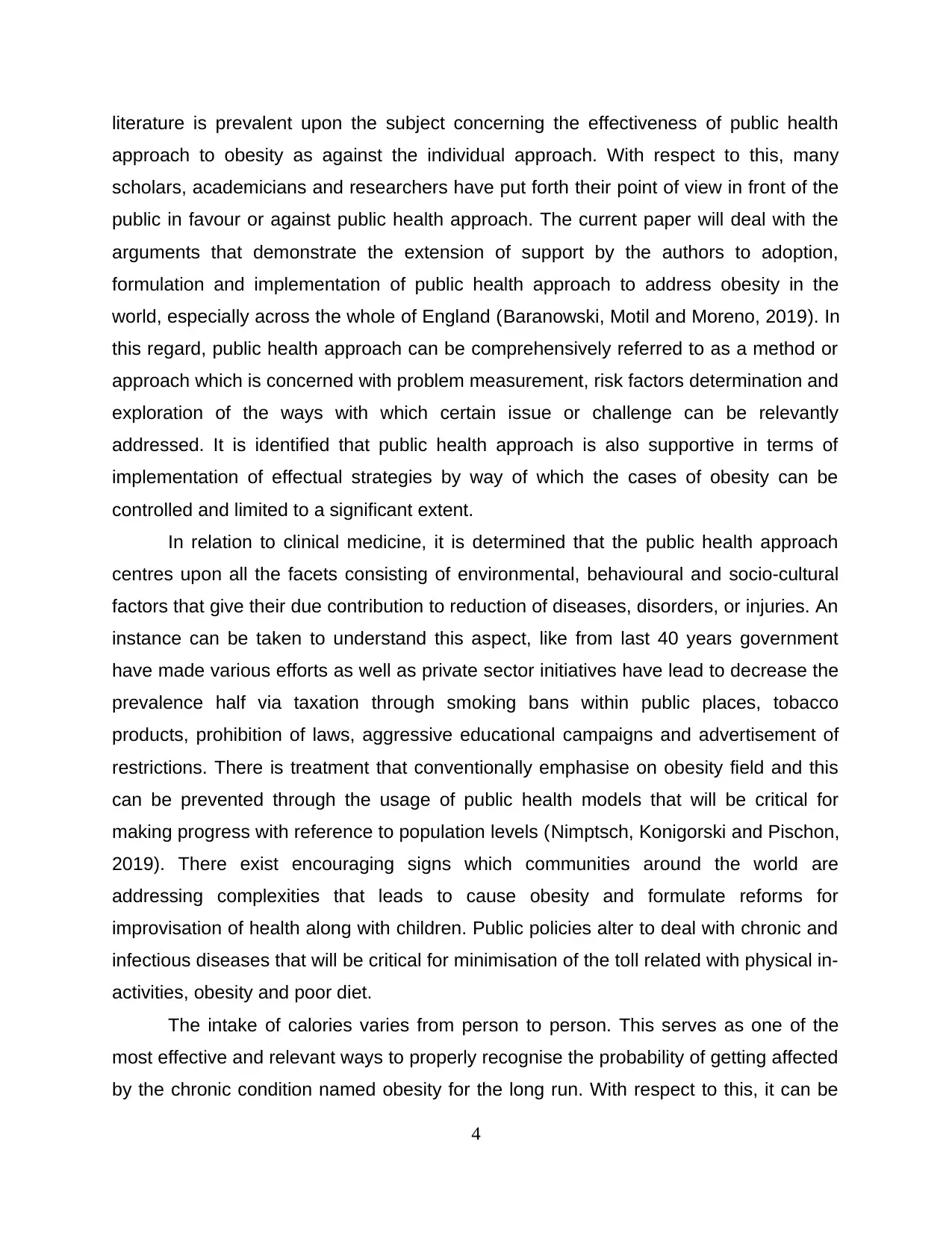
literature is prevalent upon the subject concerning the effectiveness of public health
approach to obesity as against the individual approach. With respect to this, many
scholars, academicians and researchers have put forth their point of view in front of the
public in favour or against public health approach. The current paper will deal with the
arguments that demonstrate the extension of support by the authors to adoption,
formulation and implementation of public health approach to address obesity in the
world, especially across the whole of England (Baranowski, Motil and Moreno, 2019). In
this regard, public health approach can be comprehensively referred to as a method or
approach which is concerned with problem measurement, risk factors determination and
exploration of the ways with which certain issue or challenge can be relevantly
addressed. It is identified that public health approach is also supportive in terms of
implementation of effectual strategies by way of which the cases of obesity can be
controlled and limited to a significant extent.
In relation to clinical medicine, it is determined that the public health approach
centres upon all the facets consisting of environmental, behavioural and socio-cultural
factors that give their due contribution to reduction of diseases, disorders, or injuries. An
instance can be taken to understand this aspect, like from last 40 years government
have made various efforts as well as private sector initiatives have lead to decrease the
prevalence half via taxation through smoking bans within public places, tobacco
products, prohibition of laws, aggressive educational campaigns and advertisement of
restrictions. There is treatment that conventionally emphasise on obesity field and this
can be prevented through the usage of public health models that will be critical for
making progress with reference to population levels (Nimptsch, Konigorski and Pischon,
2019). There exist encouraging signs which communities around the world are
addressing complexities that leads to cause obesity and formulate reforms for
improvisation of health along with children. Public policies alter to deal with chronic and
infectious diseases that will be critical for minimisation of the toll related with physical in-
activities, obesity and poor diet.
The intake of calories varies from person to person. This serves as one of the
most effective and relevant ways to properly recognise the probability of getting affected
by the chronic condition named obesity for the long run. With respect to this, it can be
4
approach to obesity as against the individual approach. With respect to this, many
scholars, academicians and researchers have put forth their point of view in front of the
public in favour or against public health approach. The current paper will deal with the
arguments that demonstrate the extension of support by the authors to adoption,
formulation and implementation of public health approach to address obesity in the
world, especially across the whole of England (Baranowski, Motil and Moreno, 2019). In
this regard, public health approach can be comprehensively referred to as a method or
approach which is concerned with problem measurement, risk factors determination and
exploration of the ways with which certain issue or challenge can be relevantly
addressed. It is identified that public health approach is also supportive in terms of
implementation of effectual strategies by way of which the cases of obesity can be
controlled and limited to a significant extent.
In relation to clinical medicine, it is determined that the public health approach
centres upon all the facets consisting of environmental, behavioural and socio-cultural
factors that give their due contribution to reduction of diseases, disorders, or injuries. An
instance can be taken to understand this aspect, like from last 40 years government
have made various efforts as well as private sector initiatives have lead to decrease the
prevalence half via taxation through smoking bans within public places, tobacco
products, prohibition of laws, aggressive educational campaigns and advertisement of
restrictions. There is treatment that conventionally emphasise on obesity field and this
can be prevented through the usage of public health models that will be critical for
making progress with reference to population levels (Nimptsch, Konigorski and Pischon,
2019). There exist encouraging signs which communities around the world are
addressing complexities that leads to cause obesity and formulate reforms for
improvisation of health along with children. Public policies alter to deal with chronic and
infectious diseases that will be critical for minimisation of the toll related with physical in-
activities, obesity and poor diet.
The intake of calories varies from person to person. This serves as one of the
most effective and relevant ways to properly recognise the probability of getting affected
by the chronic condition named obesity for the long run. With respect to this, it can be
4
Paraphrase This Document
Need a fresh take? Get an instant paraphrase of this document with our AI Paraphraser
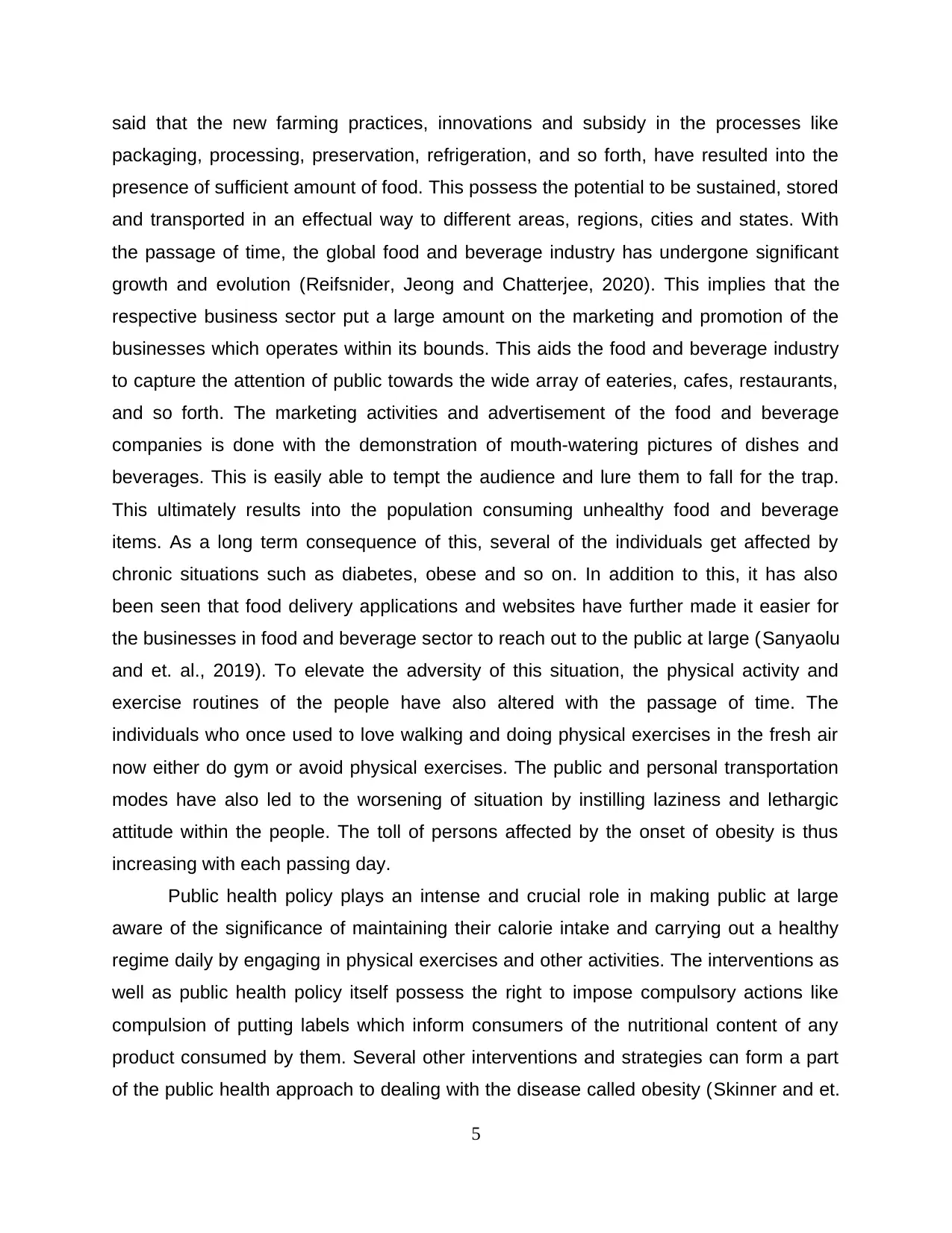
said that the new farming practices, innovations and subsidy in the processes like
packaging, processing, preservation, refrigeration, and so forth, have resulted into the
presence of sufficient amount of food. This possess the potential to be sustained, stored
and transported in an effectual way to different areas, regions, cities and states. With
the passage of time, the global food and beverage industry has undergone significant
growth and evolution (Reifsnider, Jeong and Chatterjee, 2020). This implies that the
respective business sector put a large amount on the marketing and promotion of the
businesses which operates within its bounds. This aids the food and beverage industry
to capture the attention of public towards the wide array of eateries, cafes, restaurants,
and so forth. The marketing activities and advertisement of the food and beverage
companies is done with the demonstration of mouth-watering pictures of dishes and
beverages. This is easily able to tempt the audience and lure them to fall for the trap.
This ultimately results into the population consuming unhealthy food and beverage
items. As a long term consequence of this, several of the individuals get affected by
chronic situations such as diabetes, obese and so on. In addition to this, it has also
been seen that food delivery applications and websites have further made it easier for
the businesses in food and beverage sector to reach out to the public at large (Sanyaolu
and et. al., 2019). To elevate the adversity of this situation, the physical activity and
exercise routines of the people have also altered with the passage of time. The
individuals who once used to love walking and doing physical exercises in the fresh air
now either do gym or avoid physical exercises. The public and personal transportation
modes have also led to the worsening of situation by instilling laziness and lethargic
attitude within the people. The toll of persons affected by the onset of obesity is thus
increasing with each passing day.
Public health policy plays an intense and crucial role in making public at large
aware of the significance of maintaining their calorie intake and carrying out a healthy
regime daily by engaging in physical exercises and other activities. The interventions as
well as public health policy itself possess the right to impose compulsory actions like
compulsion of putting labels which inform consumers of the nutritional content of any
product consumed by them. Several other interventions and strategies can form a part
of the public health approach to dealing with the disease called obesity (Skinner and et.
5
packaging, processing, preservation, refrigeration, and so forth, have resulted into the
presence of sufficient amount of food. This possess the potential to be sustained, stored
and transported in an effectual way to different areas, regions, cities and states. With
the passage of time, the global food and beverage industry has undergone significant
growth and evolution (Reifsnider, Jeong and Chatterjee, 2020). This implies that the
respective business sector put a large amount on the marketing and promotion of the
businesses which operates within its bounds. This aids the food and beverage industry
to capture the attention of public towards the wide array of eateries, cafes, restaurants,
and so forth. The marketing activities and advertisement of the food and beverage
companies is done with the demonstration of mouth-watering pictures of dishes and
beverages. This is easily able to tempt the audience and lure them to fall for the trap.
This ultimately results into the population consuming unhealthy food and beverage
items. As a long term consequence of this, several of the individuals get affected by
chronic situations such as diabetes, obese and so on. In addition to this, it has also
been seen that food delivery applications and websites have further made it easier for
the businesses in food and beverage sector to reach out to the public at large (Sanyaolu
and et. al., 2019). To elevate the adversity of this situation, the physical activity and
exercise routines of the people have also altered with the passage of time. The
individuals who once used to love walking and doing physical exercises in the fresh air
now either do gym or avoid physical exercises. The public and personal transportation
modes have also led to the worsening of situation by instilling laziness and lethargic
attitude within the people. The toll of persons affected by the onset of obesity is thus
increasing with each passing day.
Public health policy plays an intense and crucial role in making public at large
aware of the significance of maintaining their calorie intake and carrying out a healthy
regime daily by engaging in physical exercises and other activities. The interventions as
well as public health policy itself possess the right to impose compulsory actions like
compulsion of putting labels which inform consumers of the nutritional content of any
product consumed by them. Several other interventions and strategies can form a part
of the public health approach to dealing with the disease called obesity (Skinner and et.
5
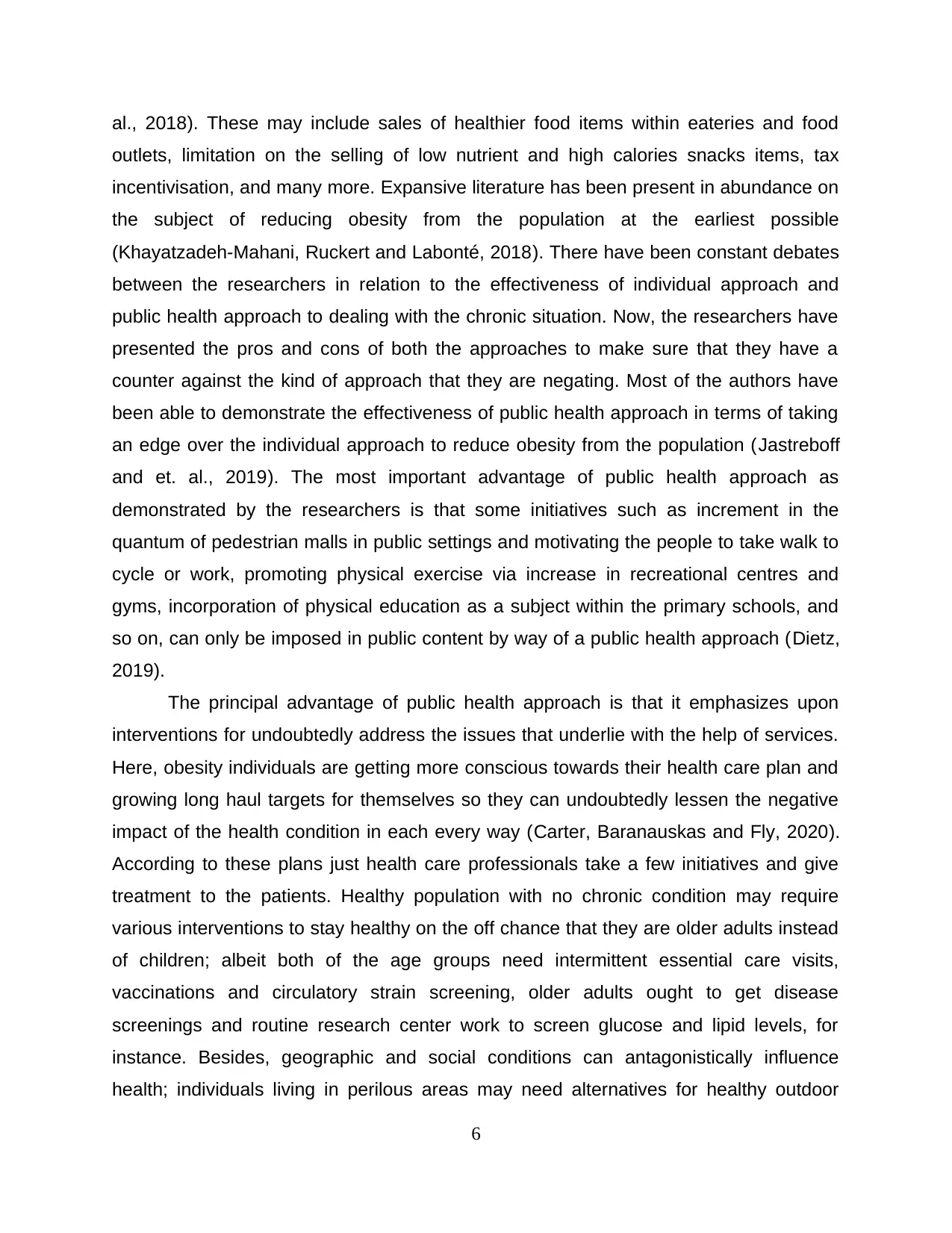
al., 2018). These may include sales of healthier food items within eateries and food
outlets, limitation on the selling of low nutrient and high calories snacks items, tax
incentivisation, and many more. Expansive literature has been present in abundance on
the subject of reducing obesity from the population at the earliest possible
(Khayatzadeh-Mahani, Ruckert and Labonté, 2018). There have been constant debates
between the researchers in relation to the effectiveness of individual approach and
public health approach to dealing with the chronic situation. Now, the researchers have
presented the pros and cons of both the approaches to make sure that they have a
counter against the kind of approach that they are negating. Most of the authors have
been able to demonstrate the effectiveness of public health approach in terms of taking
an edge over the individual approach to reduce obesity from the population (Jastreboff
and et. al., 2019). The most important advantage of public health approach as
demonstrated by the researchers is that some initiatives such as increment in the
quantum of pedestrian malls in public settings and motivating the people to take walk to
cycle or work, promoting physical exercise via increase in recreational centres and
gyms, incorporation of physical education as a subject within the primary schools, and
so on, can only be imposed in public content by way of a public health approach (Dietz,
2019).
The principal advantage of public health approach is that it emphasizes upon
interventions for undoubtedly address the issues that underlie with the help of services.
Here, obesity individuals are getting more conscious towards their health care plan and
growing long haul targets for themselves so they can undoubtedly lessen the negative
impact of the health condition in each every way (Carter, Baranauskas and Fly, 2020).
According to these plans just health care professionals take a few initiatives and give
treatment to the patients. Healthy population with no chronic condition may require
various interventions to stay healthy on the off chance that they are older adults instead
of children; albeit both of the age groups need intermittent essential care visits,
vaccinations and circulatory strain screening, older adults ought to get disease
screenings and routine research center work to screen glucose and lipid levels, for
instance. Besides, geographic and social conditions can antagonistically influence
health; individuals living in perilous areas may need alternatives for healthy outdoor
6
outlets, limitation on the selling of low nutrient and high calories snacks items, tax
incentivisation, and many more. Expansive literature has been present in abundance on
the subject of reducing obesity from the population at the earliest possible
(Khayatzadeh-Mahani, Ruckert and Labonté, 2018). There have been constant debates
between the researchers in relation to the effectiveness of individual approach and
public health approach to dealing with the chronic situation. Now, the researchers have
presented the pros and cons of both the approaches to make sure that they have a
counter against the kind of approach that they are negating. Most of the authors have
been able to demonstrate the effectiveness of public health approach in terms of taking
an edge over the individual approach to reduce obesity from the population (Jastreboff
and et. al., 2019). The most important advantage of public health approach as
demonstrated by the researchers is that some initiatives such as increment in the
quantum of pedestrian malls in public settings and motivating the people to take walk to
cycle or work, promoting physical exercise via increase in recreational centres and
gyms, incorporation of physical education as a subject within the primary schools, and
so on, can only be imposed in public content by way of a public health approach (Dietz,
2019).
The principal advantage of public health approach is that it emphasizes upon
interventions for undoubtedly address the issues that underlie with the help of services.
Here, obesity individuals are getting more conscious towards their health care plan and
growing long haul targets for themselves so they can undoubtedly lessen the negative
impact of the health condition in each every way (Carter, Baranauskas and Fly, 2020).
According to these plans just health care professionals take a few initiatives and give
treatment to the patients. Healthy population with no chronic condition may require
various interventions to stay healthy on the off chance that they are older adults instead
of children; albeit both of the age groups need intermittent essential care visits,
vaccinations and circulatory strain screening, older adults ought to get disease
screenings and routine research center work to screen glucose and lipid levels, for
instance. Besides, geographic and social conditions can antagonistically influence
health; individuals living in perilous areas may need alternatives for healthy outdoor
6
⊘ This is a preview!⊘
Do you want full access?
Subscribe today to unlock all pages.

Trusted by 1+ million students worldwide
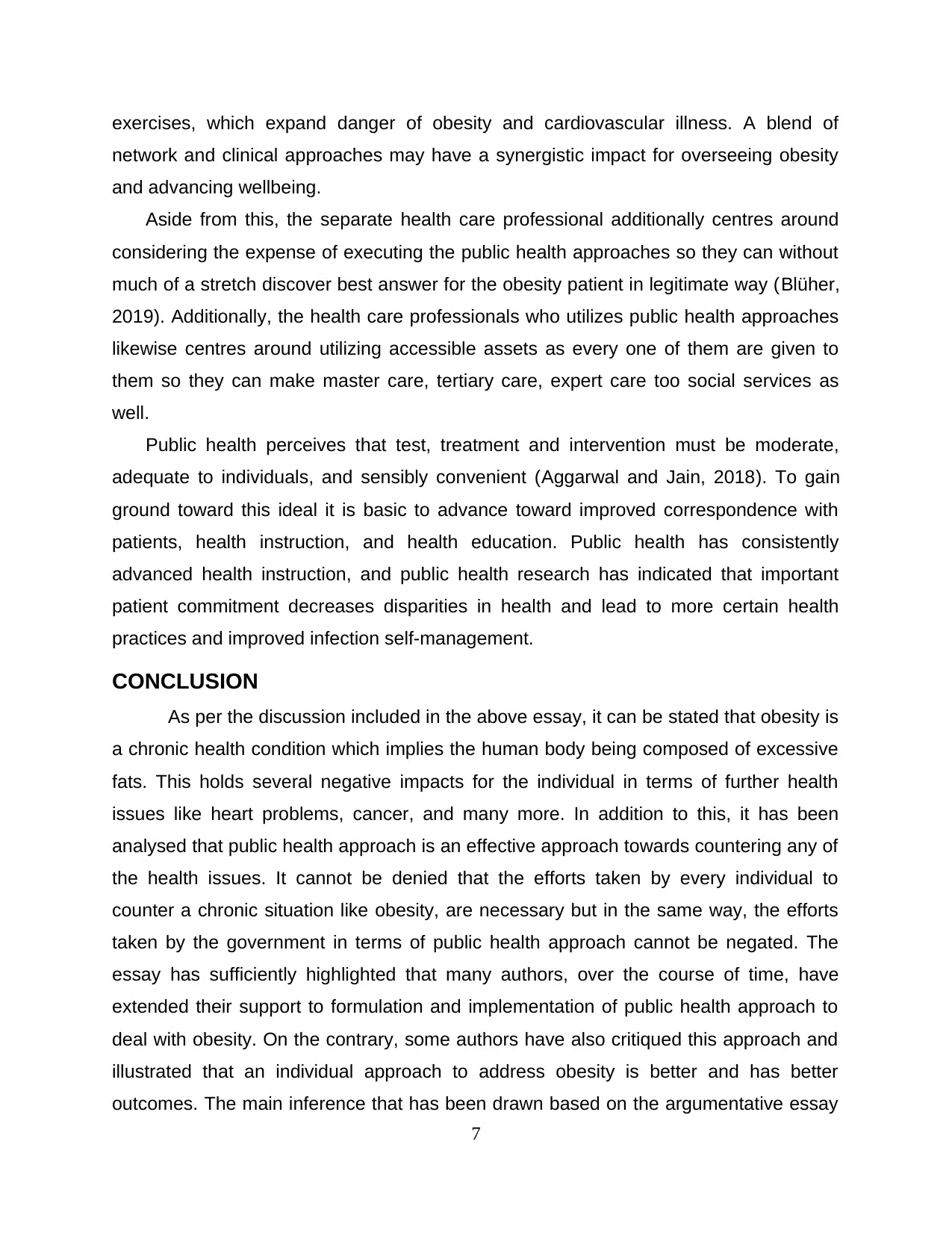
exercises, which expand danger of obesity and cardiovascular illness. A blend of
network and clinical approaches may have a synergistic impact for overseeing obesity
and advancing wellbeing.
Aside from this, the separate health care professional additionally centres around
considering the expense of executing the public health approaches so they can without
much of a stretch discover best answer for the obesity patient in legitimate way (Blüher,
2019). Additionally, the health care professionals who utilizes public health approaches
likewise centres around utilizing accessible assets as every one of them are given to
them so they can make master care, tertiary care, expert care too social services as
well.
Public health perceives that test, treatment and intervention must be moderate,
adequate to individuals, and sensibly convenient (Aggarwal and Jain, 2018). To gain
ground toward this ideal it is basic to advance toward improved correspondence with
patients, health instruction, and health education. Public health has consistently
advanced health instruction, and public health research has indicated that important
patient commitment decreases disparities in health and lead to more certain health
practices and improved infection self-management.
CONCLUSION
As per the discussion included in the above essay, it can be stated that obesity is
a chronic health condition which implies the human body being composed of excessive
fats. This holds several negative impacts for the individual in terms of further health
issues like heart problems, cancer, and many more. In addition to this, it has been
analysed that public health approach is an effective approach towards countering any of
the health issues. It cannot be denied that the efforts taken by every individual to
counter a chronic situation like obesity, are necessary but in the same way, the efforts
taken by the government in terms of public health approach cannot be negated. The
essay has sufficiently highlighted that many authors, over the course of time, have
extended their support to formulation and implementation of public health approach to
deal with obesity. On the contrary, some authors have also critiqued this approach and
illustrated that an individual approach to address obesity is better and has better
outcomes. The main inference that has been drawn based on the argumentative essay
7
network and clinical approaches may have a synergistic impact for overseeing obesity
and advancing wellbeing.
Aside from this, the separate health care professional additionally centres around
considering the expense of executing the public health approaches so they can without
much of a stretch discover best answer for the obesity patient in legitimate way (Blüher,
2019). Additionally, the health care professionals who utilizes public health approaches
likewise centres around utilizing accessible assets as every one of them are given to
them so they can make master care, tertiary care, expert care too social services as
well.
Public health perceives that test, treatment and intervention must be moderate,
adequate to individuals, and sensibly convenient (Aggarwal and Jain, 2018). To gain
ground toward this ideal it is basic to advance toward improved correspondence with
patients, health instruction, and health education. Public health has consistently
advanced health instruction, and public health research has indicated that important
patient commitment decreases disparities in health and lead to more certain health
practices and improved infection self-management.
CONCLUSION
As per the discussion included in the above essay, it can be stated that obesity is
a chronic health condition which implies the human body being composed of excessive
fats. This holds several negative impacts for the individual in terms of further health
issues like heart problems, cancer, and many more. In addition to this, it has been
analysed that public health approach is an effective approach towards countering any of
the health issues. It cannot be denied that the efforts taken by every individual to
counter a chronic situation like obesity, are necessary but in the same way, the efforts
taken by the government in terms of public health approach cannot be negated. The
essay has sufficiently highlighted that many authors, over the course of time, have
extended their support to formulation and implementation of public health approach to
deal with obesity. On the contrary, some authors have also critiqued this approach and
illustrated that an individual approach to address obesity is better and has better
outcomes. The main inference that has been drawn based on the argumentative essay
7
Paraphrase This Document
Need a fresh take? Get an instant paraphrase of this document with our AI Paraphraser
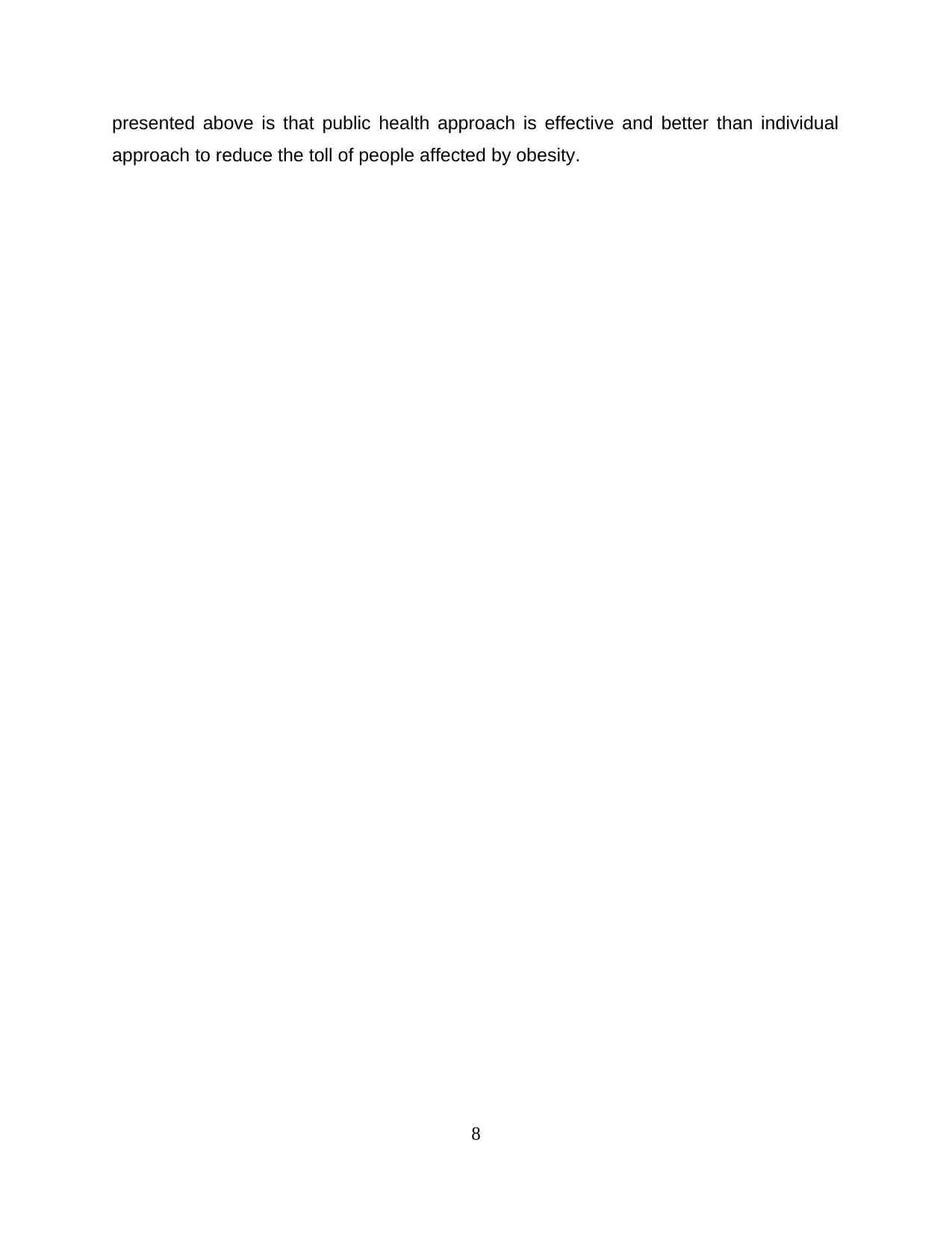
presented above is that public health approach is effective and better than individual
approach to reduce the toll of people affected by obesity.
8
approach to reduce the toll of people affected by obesity.
8
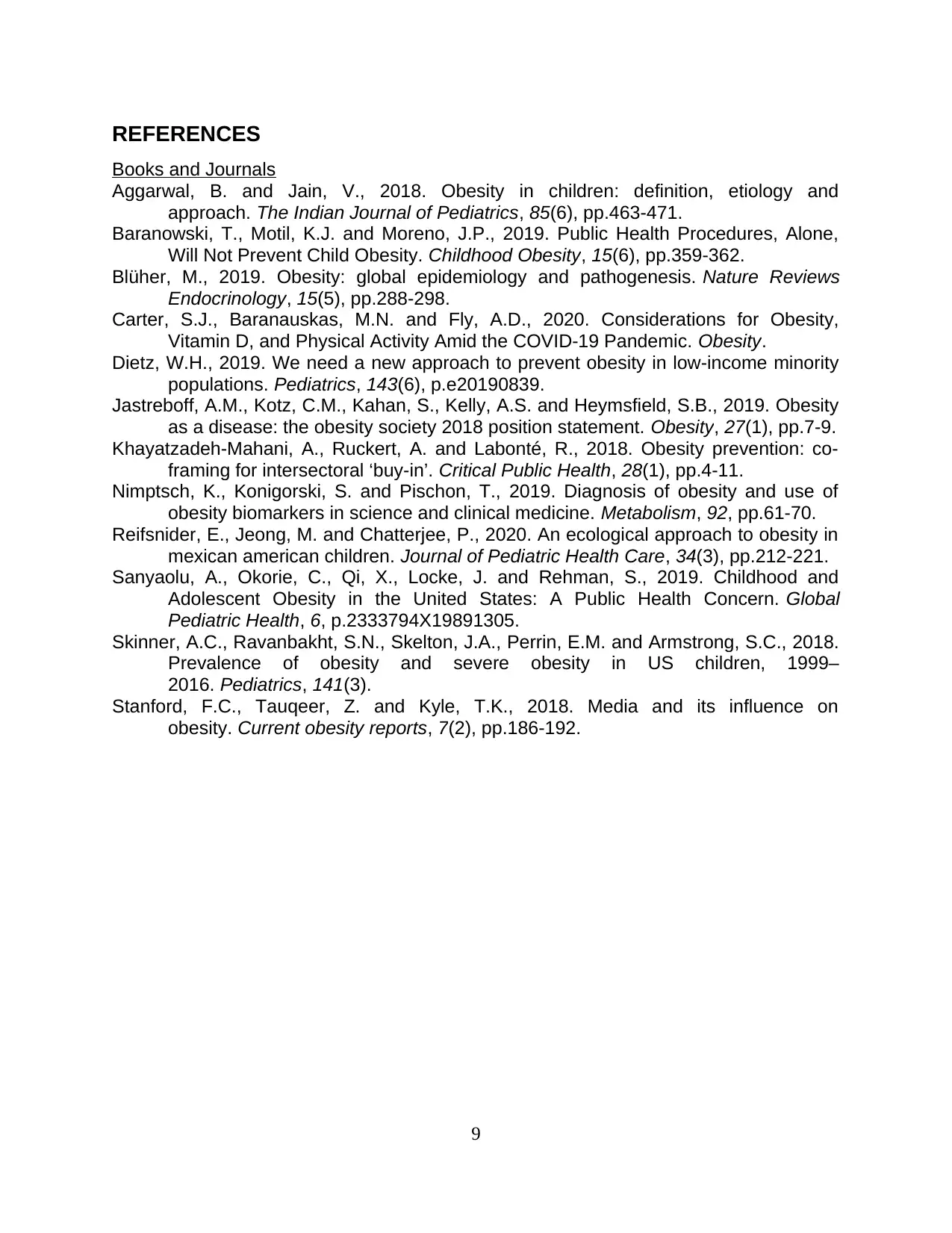
REFERENCES
Books and Journals
Aggarwal, B. and Jain, V., 2018. Obesity in children: definition, etiology and
approach. The Indian Journal of Pediatrics, 85(6), pp.463-471.
Baranowski, T., Motil, K.J. and Moreno, J.P., 2019. Public Health Procedures, Alone,
Will Not Prevent Child Obesity. Childhood Obesity, 15(6), pp.359-362.
Blüher, M., 2019. Obesity: global epidemiology and pathogenesis. Nature Reviews
Endocrinology, 15(5), pp.288-298.
Carter, S.J., Baranauskas, M.N. and Fly, A.D., 2020. Considerations for Obesity,
Vitamin D, and Physical Activity Amid the COVID‐19 Pandemic. Obesity.
Dietz, W.H., 2019. We need a new approach to prevent obesity in low-income minority
populations. Pediatrics, 143(6), p.e20190839.
Jastreboff, A.M., Kotz, C.M., Kahan, S., Kelly, A.S. and Heymsfield, S.B., 2019. Obesity
as a disease: the obesity society 2018 position statement. Obesity, 27(1), pp.7-9.
Khayatzadeh-Mahani, A., Ruckert, A. and Labonté, R., 2018. Obesity prevention: co-
framing for intersectoral ‘buy-in’. Critical Public Health, 28(1), pp.4-11.
Nimptsch, K., Konigorski, S. and Pischon, T., 2019. Diagnosis of obesity and use of
obesity biomarkers in science and clinical medicine. Metabolism, 92, pp.61-70.
Reifsnider, E., Jeong, M. and Chatterjee, P., 2020. An ecological approach to obesity in
mexican american children. Journal of Pediatric Health Care, 34(3), pp.212-221.
Sanyaolu, A., Okorie, C., Qi, X., Locke, J. and Rehman, S., 2019. Childhood and
Adolescent Obesity in the United States: A Public Health Concern. Global
Pediatric Health, 6, p.2333794X19891305.
Skinner, A.C., Ravanbakht, S.N., Skelton, J.A., Perrin, E.M. and Armstrong, S.C., 2018.
Prevalence of obesity and severe obesity in US children, 1999–
2016. Pediatrics, 141(3).
Stanford, F.C., Tauqeer, Z. and Kyle, T.K., 2018. Media and its influence on
obesity. Current obesity reports, 7(2), pp.186-192.
9
Books and Journals
Aggarwal, B. and Jain, V., 2018. Obesity in children: definition, etiology and
approach. The Indian Journal of Pediatrics, 85(6), pp.463-471.
Baranowski, T., Motil, K.J. and Moreno, J.P., 2019. Public Health Procedures, Alone,
Will Not Prevent Child Obesity. Childhood Obesity, 15(6), pp.359-362.
Blüher, M., 2019. Obesity: global epidemiology and pathogenesis. Nature Reviews
Endocrinology, 15(5), pp.288-298.
Carter, S.J., Baranauskas, M.N. and Fly, A.D., 2020. Considerations for Obesity,
Vitamin D, and Physical Activity Amid the COVID‐19 Pandemic. Obesity.
Dietz, W.H., 2019. We need a new approach to prevent obesity in low-income minority
populations. Pediatrics, 143(6), p.e20190839.
Jastreboff, A.M., Kotz, C.M., Kahan, S., Kelly, A.S. and Heymsfield, S.B., 2019. Obesity
as a disease: the obesity society 2018 position statement. Obesity, 27(1), pp.7-9.
Khayatzadeh-Mahani, A., Ruckert, A. and Labonté, R., 2018. Obesity prevention: co-
framing for intersectoral ‘buy-in’. Critical Public Health, 28(1), pp.4-11.
Nimptsch, K., Konigorski, S. and Pischon, T., 2019. Diagnosis of obesity and use of
obesity biomarkers in science and clinical medicine. Metabolism, 92, pp.61-70.
Reifsnider, E., Jeong, M. and Chatterjee, P., 2020. An ecological approach to obesity in
mexican american children. Journal of Pediatric Health Care, 34(3), pp.212-221.
Sanyaolu, A., Okorie, C., Qi, X., Locke, J. and Rehman, S., 2019. Childhood and
Adolescent Obesity in the United States: A Public Health Concern. Global
Pediatric Health, 6, p.2333794X19891305.
Skinner, A.C., Ravanbakht, S.N., Skelton, J.A., Perrin, E.M. and Armstrong, S.C., 2018.
Prevalence of obesity and severe obesity in US children, 1999–
2016. Pediatrics, 141(3).
Stanford, F.C., Tauqeer, Z. and Kyle, T.K., 2018. Media and its influence on
obesity. Current obesity reports, 7(2), pp.186-192.
9
⊘ This is a preview!⊘
Do you want full access?
Subscribe today to unlock all pages.

Trusted by 1+ million students worldwide
1 out of 9
Related Documents
Your All-in-One AI-Powered Toolkit for Academic Success.
+13062052269
info@desklib.com
Available 24*7 on WhatsApp / Email
![[object Object]](/_next/static/media/star-bottom.7253800d.svg)
Unlock your academic potential
Copyright © 2020–2025 A2Z Services. All Rights Reserved. Developed and managed by ZUCOL.





